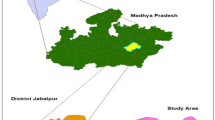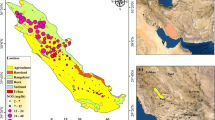Abstract
Deplorable quality of groundwater arising from saltwater intrusion, natural leaching and anthropogenic activities is one of the major concerns for the society. Assessment of groundwater quality is, therefore, a primary objective of scientific research. Here, we propose an artificial neural network-based method set in a Bayesian neural network (BNN) framework and employ it to assess groundwater quality. The approach is based on analyzing 36 water samples and inverting up to 85 Schlumberger vertical electrical sounding data. We constructed a priori model by suitably parameterizing geochemical and geophysical data collected from the western part of India. The posterior model (post-inversion) was estimated using the BNN learning procedure and global hybrid Monte Carlo/Markov Chain Monte Carlo optimization scheme. By suitable parameterization of geochemical and geophysical parameters, we simulated 1,500 training samples, out of which 50 % samples were used for training and remaining 50 % were used for validation and testing. We show that the trained model is able to classify validation and test samples with 85 % and 80 % accuracy respectively. Based on cross-correlation analysis and Gibb’s diagram of geochemical attributes, the groundwater qualities of the study area were classified into following three categories: “Very good”, “Good”, and “Unsuitable”. The BNN model-based results suggest that groundwater quality falls mostly in the range of “Good” to “Very good” except for some places near the Arabian Sea. The new modeling results powered by uncertainty and statistical analyses would provide useful constrain, which could be utilized in monitoring and assessment of the groundwater quality.








Similar content being viewed by others
References
American Public Health Association (APHA). (1985). Standard methods for the examination of water and waste (16th ed., p. 100). Washington: American Public Health Association.
Appelo, C. A. J., & Postma, D. (2005). Geochemistry, groundwater and pollution (2nd ed., p. 404). Leiden: Balkema.
Bishop, C. M. (1995). Neural networks for pattern recognition. Oxford: Oxford University Press.
Bohlke, J. K. (2002). Groundwater recharge and agricultural contamination. Hydrogeology Journal, 10, 153–179.
Brown, C. H. (1998). Applied multivariate statistics in geo-hydrology and related sciences. Berlin: Springer.
Brown, E., Skougstad, M. W., & Fishmen, M. J. (1974). Methods for collection and analysis of water samples for dissolved minerals and gases. Washington: Government Printing Office.
Central Ground Water Board (CGWB), (2009). Groundwater information Sindhudurg district Maharashtra, p.16.
Duane, S., Kennedy, A. D., Pendleton, B., & Roweth, D. (1987). Hybrid Monte Carlo. Physics Letters B, 195, 216–222.
Duraiswami, R., & Patankar, U. (2011). Occurrence of fluoride in the drinking water sources from Gad River basin, Maharashtra. Journal of Geological Society of India, 77, 167–174.
Fetter, C. W. (1988). Applied hydrogeology. Columbus: Merrill.
Gibbs, R. J. (1970). Mechanisms controlling world water chemistry. Science, 170, 1088–1090.
Hem, J. D. (1970). Study and interpretation of the chemical characteristics of natural water. Water Supply Paper-1473, US Geological Survey, pp 363.
Kannan, N., & Joseph, S. (2010). Quality of groundwater in the shallow aquifers of a paddy dominated agricultural river basin, Kerala, India. International Journal of Civil Environmental Engineering, 2, 160–178.
Long, A. J., & Valder, J. F. (2011). Multivariate analyses with end-member mixing to characterize groundwater flow: wind cave and associated aquifers. Journal of Hydrology, 409, 315–327.
Maiti, S., & Tiwari, R. K. (2009). A hybrid Monte Carlo method based artificial neural networks approach for rock boundaries identification: a case study from the KTB bore hole. Pure and Applied Geophysics, 166, 2059–2090. doi:10.1007/s00024-009-0533-y.
Maiti, S., & Tiwari, R. K. (2010). Neural network modeling and an uncertainty analysis in Bayesian framework: a case study from the KTB borehole site. Journal of Geophysical Research, 115, B10208. doi:10.1029/2010JB000864.
Maiti, S., Gupta, G., Erram, V. C., & Tiwari, R. K. (2011). Inversion of Schlumberger resistivity sounding data from the critically dynamic Koyna region using Hybrid Monte Carlo-based neural network approach. Nonlinear Processes in Geophysics, 18, 179–192. doi:10.5194/npg-18-179-2011.
Maiti, S., Gupta, G., Erram, V. C., & Tiwari, R. K. (2012). Delineation of shallow resistivity structure around Malvan, Konkan region, Maharashtra by neural network inversion using vertical electrical sounding measurements. Environmental Earth Sciences. doi:10.1007/s12665-012-1779-8.
Matlab version 7.10.0. (2010). Natick, Massachusetts: The Math Works Inc., (http://www.mathworks.com).
Menke, W. (1984). Geophysical data analysis: discrete inverse theory. New York: Academic.
Mondal, N. C., Singh, V. S., Saxena, V. K., & Singh, V. P. (2011). Assessment of seawater impact using major hydrochemical ions: a case study from Sadras, Tamilnadu, India. Environmental Monitoring and Assessment, 177, 315–335.
Nabney, I. T. (2004). Netlab algorithms for pattern recognition. New York: Springer.
Naik, P., Awashti, A. K., Anand, A. V. S. S., & Behera, P. N. (2009). Hydrogeochemistry of the Koyna River basin, India. Environmental Earth Sciences, 59, 613–629.
Panda, U. C., Sundaray, S. K., Rath, P., Nayak, B. B., & Bhatta, D. (2006). Application of factor and cluster analysis for characterization of river and estuarine water systems—a case study: Mahanadi River (India). Journal of Hydrology, 331, 434–445.
Park, S. C., Yun, S., Chae, G. T., Yoo, I. S., Shin, K. S., & Heo, C. H. (2005). Regional hydrochemical study on salinization of coastal aquifers, western coastal area of South Korea. Journal of Hydrology, 313, 182–194.
Pawar, N. J., Pondhe, G. M., & Patil, S. F. (1998). Groundwater pollution due to sugar-mill effluent at Sonai, Maharashtra, India. Environmental Geology, 34(213), 151–158.
Poulton, M. (2001). Computational neural networks for geophysical data processing. New York: Pergamon.
Pradhan, B., & Pirasteh, S. (2011). Hydro-chemical analysis of the ground water of the basaltic catchments: Upper Bhatsai Region, Maharashtra. The Open Hydrology Journal, 5, 51–57.
Prasanna, M. V., Chidambaram, S., Shahul, A., Hameed, A., & Srinivasamoorthy, K. (2011). Hydrogeochemical analysis and evaluation of groundwater quality in the Gadilam river basin, Tamil Nadu, India. Journal of Earth System Science, 120, 85–98.
Raghunath, R., Sreedhara Murthy, T. R., & Raghavan, B. R. (2001). Spatial distribution of pH, EC and total dissolved solids of Nethravathi river basin, Karnataka state, India. Pollution Research, 20, 413–418.
Rajmohan, N., & Elango, L. (2006). Hydrogeochemistry and its relation to groundwater level fluctuation in the Palar and Cheyyar river basins, southern India. Hydrological Process, 20, 2415–2427.
Rao, P. M., Sekhar, P., & Yadav, Y. S. (2004). Water quality studies on Kolleru lake and its infalling drains of A.P., India. In A. Kumar (Ed.), Water pollution (p. 171). New Delhi: APH.
Schoeller, H. (1959). Arid zone hydrology, recent developments. Paris: UNESCO.
Schoeller, H. (1967). Methods and techniques of groundwater investigation and development (Water Resources Series 33). Paris: UNESCO.
Song, S. H., Lee, J. Y., & Park, N. (2007). Use of vertical electrical soundings to delineate seawater intrusion in a coastal area of Byunsan, Korea. Environmental Geology, 52, 1207–1219.
Subba Rao, N. (2006). Seasonal variation of groundwater quality in a part of Guntur district, Andhra Pradesh, India. Environmental Geology, 49, 413–429.
Sun, T., Pan, S. B., & Li, Y. J. (2004). Application of artificial neural network model to groundwater quality assessment and classification. Hydrogeology and Engineering Geology, 3, 58–61.
Tarantola, A. (1987). Inverse problem theory. New York: Elsevier.
Tiwari, R. K., & Maiti, S. (2011). Bayesian neural network modeling of tree-ring temperature variability record from the Western Himalayas. Nonlinear Processes in Geophysics, 18, 515–528. doi:10.5194/npg-18-515-2011.
Todd, D. K. (1959). Groundwater hydrology (pp. 277–294). New York: Wiley.
Van der Bann, M., & Jutten, C. (2000). Neural networks in geophysical applications. Geophysics, 65, 1032–1047.
Willmott, C. J. (1981). On the validation of models. Physical Geography, 2, 184–194.
World Health Organization (WHO). (1984). Guideline of drinking quality (pp. 333–335). Washington: World Health Organization.
Zou, Z. H., & Wang, H. (2007). Application of BP modeling based on random samples to assessment on natural water quality. Environmental Engineering, 25, 69–71.
Zou, Z. H., & Wang, H. (2010). Adaptive neuro fuzzy inference system for classification of water quality status. Journal of Environmental Sciences, 22, 1891–1896.
Acknowledgments
We are thankful to the Directors, Indian Institute of Geomagnetism, New-Panvel and NGRI, Hyderabad for their kind permission to publish the work.
Author information
Authors and Affiliations
Corresponding author
Appendix
Appendix
Rights and permissions
About this article
Cite this article
Maiti, S., Erram, V.C., Gupta, G. et al. Assessment of groundwater quality: a fusion of geochemical and geophysical information via Bayesian neural networks. Environ Monit Assess 185, 3445–3465 (2013). https://doi.org/10.1007/s10661-012-2802-y
Received:
Accepted:
Published:
Issue Date:
DOI: https://doi.org/10.1007/s10661-012-2802-y









